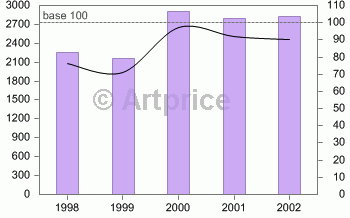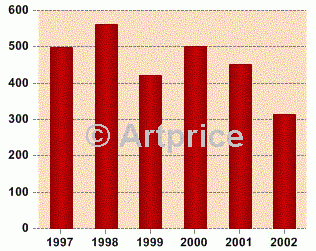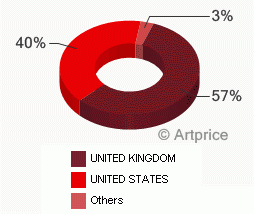Rembrandt Van Rijn (1606-1669)
[25/06/2003]
Born in 1606 at Leiden, Rembrandt was one of six children born to Gerritsz van Rijn. He entered Leiden University at 14, but left to study painting with local artist Jacob van Swanenburch, before completing his training with Peter Lastman in Amsterdam. When he returned to Leiden to open his own studio, he met with instant success. At 22 he took on his first pupil. And in 1631, his burgeoning reputation allowed him to move to Amsterdam. In 1634 he married Saskia van Uylenburgh, who died eight years later. His studio took off and he was soon overwhelmed with commissions for portraits or religious paintings. As time went by Rembrandt began working with fewer brushstrokes, suggesting rather than depicting the objects in his paintings. In the same period he produced a great many prints and etchings. But despite his financial success as teacher, painter and art dealer, his ostentatious life style forced him into bankruptcy in 1656, and his house, studio and all their valuable contents were auctioned to defray his debts. A year later REMBRANDT VAN RIJN was taken under the wing of his mistress Hendrickje Stoffels and son Titus, who together set up an art-dealing company to save him from his creditors. When Rembrandt died in 1669, he left behind an extraordinary series of 60 self-portraits. One, a 70cm high self-portrait painted in 1634, is coming up for auction at Sotheby’s on 10 July 2003, estimated at USD4-6m.
Artworks at auctions
This master of the Dutch School, had a prolific output, with some 600 paintings, 300 prints and 1,400 drawings. But barely a dozen have been seen in auction rooms in the last ten years. The most expensive Portrait of a Lady, Aged 62 (Perhaps Aeltje Pieterdr. Uylenburgh) (1632), sold for GBP 18m (EUR29.6m) in December 2000. Rembrandt’s drawings are equally scarce at auction. Those from the 1630s are mainly done in black or ochre chalk. But collectors prefer the later drawings, done in pen. The bulwark “De Rose” and the windmill “De Smeerpot”, the priciest of the later drawings, sold for USD3.4m in January 2000 at Christie’s. Prints though are more common and make up 99% of all lots sold. Of the 300-500 prints sold at auction each year, the most sought-after is still the portrait of Jan Six. A proof of the last state of this etching and drypoint was sold at Sotheby’s in New York for USD560,000 on 13 May 1993. However, exceptional proofs aside, 90% of Rembrandt’s prints sell for under EUR10,000. In 2002, 91 etchings changed hands for under EUR1,500.
The market places
The predominance of prints on the market means that many European collectors can regularly find works in Germany, France, the Netherlands and the UK. But the best pieces still come up in London or New York, which together generated 97% of Rembrandt’s 1999-2002 turnover.
Buy or sell
The record prices for Rembrandt paintings in 2000 have boosted sales in the lesser mediums, and the print market saw a 35% increase that year. Since then, print price levels have been fairly stable, which is more normal. On today’s market, you will have to pay, on average, EUR2,800 to get hold of a Rembrandt print. Apart from the number of the state, prices in an edition can vary tremendously from one proof to another, depending on the amount of spotting present, the condition of the paper, evidence of damage, and also the quality of the printing.Thus, despite the general variation of price levels for Rembrandt, one his best-known etchings, The Three Trees, was sold at auction from between USD25,000 and 120,000 over the past five years.
Rembrandt Van Rijn (1606-1669)Price trends for printscurrency: EUR  Rembrandt Van Rijn (1606-1669) Lots sold at auctions
Rembrandt Van Rijn (1606-1669) Lots sold at auctions  Rembrandt Van Rijn (1606-1669) Auction sales turnover 1999-2002 / weight by country
Rembrandt Van Rijn (1606-1669) Auction sales turnover 1999-2002 / weight by country  © Artprice
© Artprice




 0
0
